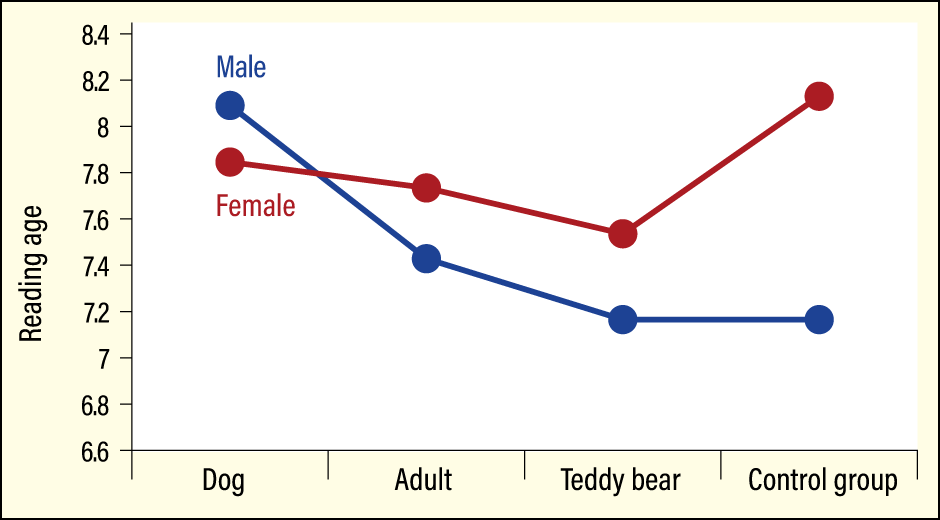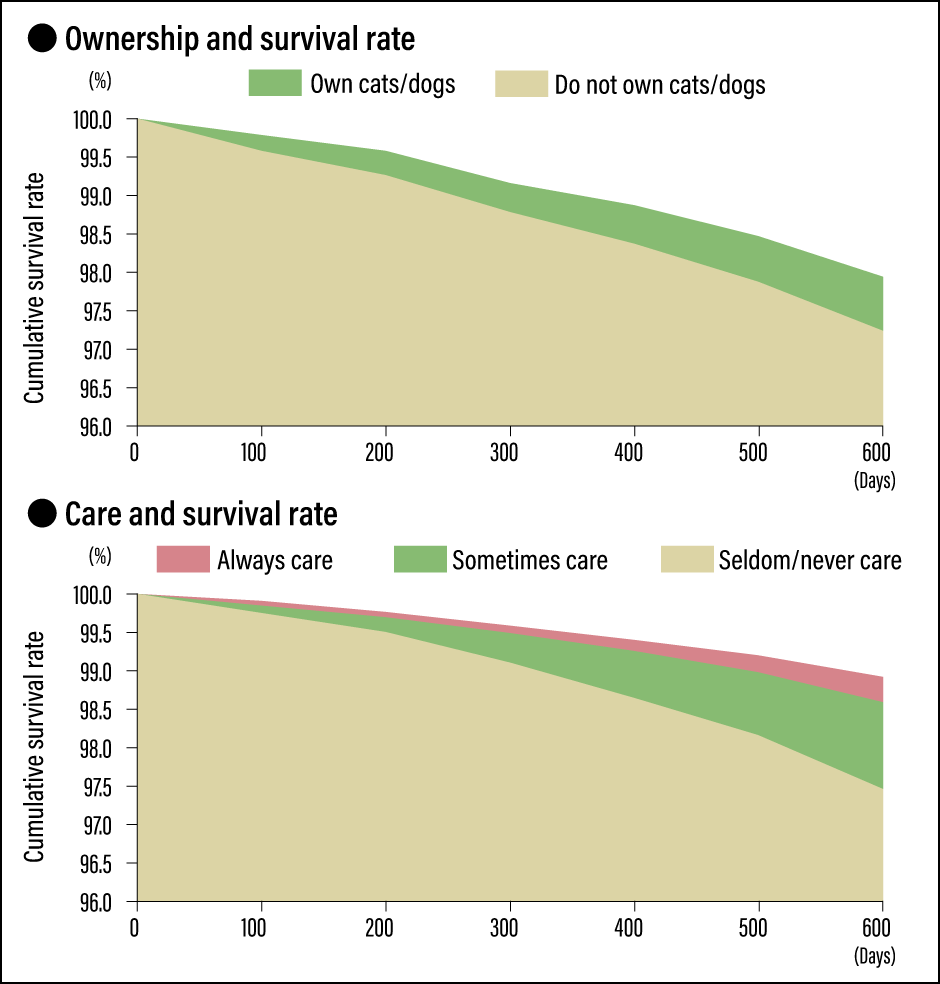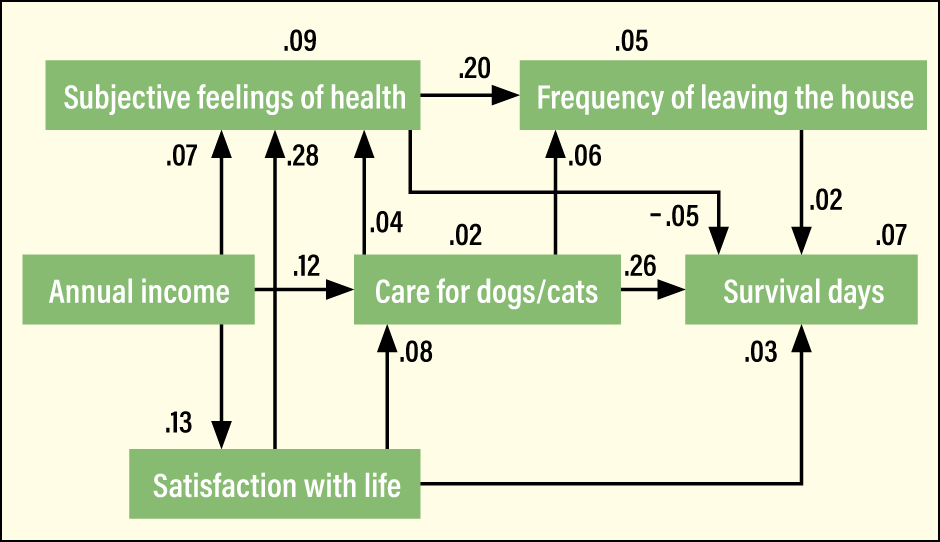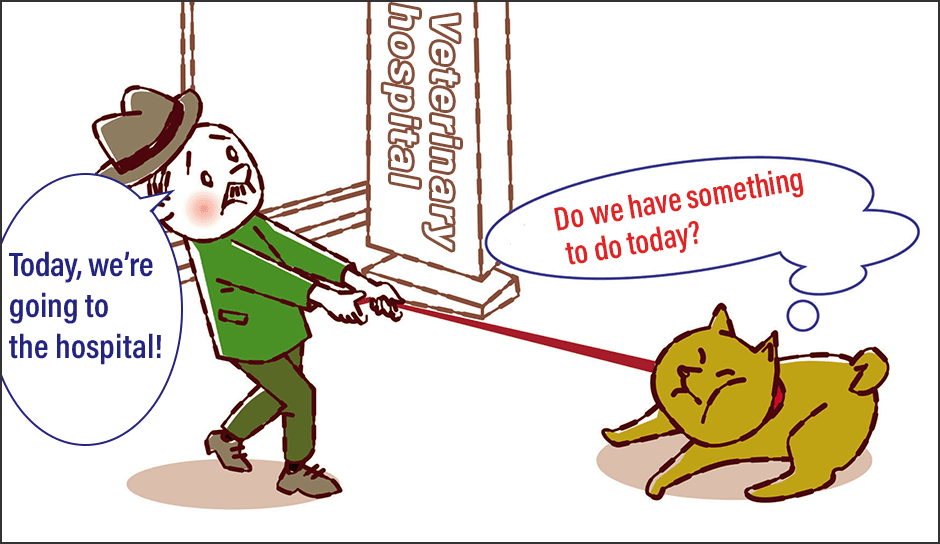Many people have experienced how interacting with animals makes them feel calmer and more positive. For animal lovers, keeping a pet has a special significance beyond simply rearing an animal. Research is progressing in other countries, investigating the commonly accepted view that pets affect people’s emotions and positively affect their health. This was previously understood from experience, and solid evidence is beginning to emerge. The benefits of pets demonstrated scientifically in this way are now contributing to people’s health.
Special Feature 1 – Living with Pets What benefits does interacting with animals have on human health?
composition by Rie Iizuka
illustration by Koji Kominato
For many years, I have been undertaking research into healthy life expectancy, with a primary focus on public health. In the course of this work, I have come to think about the effects of pets on human health.
Pets are members of the family
Looking back, when my daughter brought home a puppy, I became aware of the power of animals. That puppy instantly became the apple of our family’s eye, and it also used to play with the other children in our neighborhood. Watching them play, I felt that our pet was affecting the children’s social and emotional education. At that time, I happened to encounter a collection of essays on pets from overseas featuring a systematic discussion of the power of pets, which I had understood from experience, and my interest was aroused upon learning that scientific evidence had been found.
According to a survey by the Japan Pet Food Association, as of 2023, there are estimated to be around 6.84 million pet dogs and around 9.07 million pet cats nationwide. In days gone by, pets were assigned roles like guard dog or mouse-catcher, but today, the way we think about pets is changing. Family structures have changed, and pets have assumed roles humans should typically handle. Consequently, as family members, pets have become regarded as objects of nurture, protection, and affection.
Looking at the relationship between health and pet ownership, a study has found that pet owners visited medical institutions to seek care less frequently and had lower medical costs than non-pet owners.
In particular, dog owners tend to exercise more than those who own other pets or no pets at all. Dog ownership increases the amount of exercise taken because dogs need to be taken for a walk, but interestingly, dog owners also tend to be more active in ways other than taking their dogs for a walk. This has been reported in several studies.
For example, a survey of residents in the U.S. state of Michigan reported that, compared with non-dog owners, the odds of subjects walking at least 150 minutes per week were 34% higher for dog owners. In addition, the results showed that the odds of doing any leisure-time physical activity were 69% higher for dog owners than non-dog owners. We can surmise from this that pet ownership brings about a change in everyday lifestyle behaviors. Given that exercise undoubtedly contributes to mental and physical health, this benefit of pet ownership deserves attention when rising medical costs among older adults, in particular, is a problem.
Pets affect the mental and physical health of many people, whatever their age or gender. First, let us look at children.
I am sure that parents and guardians who have had a pet have experienced for themselves how pets help to enrich children’s growth. Let us look at an experiment carried out at a facility providing care for preschoolers, which investigated differences in preschoolers’ behavior in the presence of a natural dog and a stuffed dog.
In the case of the natural dog, the children reportedly developed a friendly relationship with it, stroking and talking to it, and the children became more proactive in their behavior. It was reported that the real dog walked around, approaching the children to greet them and that this might have activated the children’s ability to think, understand, and make judgments. The children also began to follow the teacher’s instructions. These changes in the children did not occur in the presence of the stuffed dog.
Pets help to maintain physical health
There is another interesting report from South Africa concerning learning ability.
In a study of reading aloud that focused on third-grade students, the children were divided into three groups: a group that read aloud to a dog, a group that read aloud to an adult, and a group that read aloud to a teddy bear. Their proficiency levels were then compared. The results showed that children in the group who had read aloud to a dog demonstrated higher reading rates, accuracy, and comprehension than the children in the other groups (Figure 1).
 Modified from Le Roux MC, et al. Child and Youth Care Forum, 43:655-673, 2014.
Modified from Le Roux MC, et al. Child and Youth Care Forum, 43:655-673, 2014.
Figure 1. Correlation between gender and reading age in the four groupsIn the survey of children’s ability to read aloud, children in the group who had read aloud to a dog demonstrated improved reading rates, accuracy, and comprehension compared to children in other groups. The presence of the dog calmed them and increased their ability to concentrate.
What about the effects on children’s bodies?
Several studies have shown that, in the case of adults, ownership of a pet, particularly a dog, increases opportunities to leave the house, thereby improving cardiopulmonary function and maintaining all-around physical health. Similar reports have emerged from studies involving children.
In a British survey of 2,065 children aged 9 to 10, children from households that owned a dog were found to be more active and take more daily steps. Dogs do need to be walked, of course, but it might also be that even within the home, children move more when caring for dogs and other pets. Some results have even shown that having a pet at home has an effect in preventing obesity. Another study has reported that children’s motor skills improved in the presence of a dog, and they performed tasks faster and more proactively.
In Japan, declining motor skills due to a fall in the amount of time that children spend exercising have become a problem. However, even looking at this point alone, one can see that owning a pet positively contributes to health.
We also know from past studies that children’s language functions develop along with their motor function. In other words, scientists say that the presence of a pet improves both motor and learning functions.
Dogs also play an active role at medical facilities. In a U.S. study, when canine visitation therapy —— in which a dog is brought to visit patients —— was provided for 25 children aged between 5 and 18 who had recently undergone surgery, many of the children responded that their perception of physical and mental pain had diminished. It is thought that interaction with the dog caused the secretion of endorphins, which have a sedative effect. At a university in the U.S. state of Nebraska, the blood pressure and heart rate of 23 children between 3 and 6 were measured during medical examinations to compare the figures when a dog was present and when it was not. The survey showed that both blood pressure and heart rate were lower with a dog there, demonstrating that its presence alleviated stress. Thus, dogs can also demonstrate their power in medical settings.
One exciting study concerns the topic of allergies.
A survey conducted by the Ministry of Health, Labour and Welfare shows that the number of people with allergies increases yearly. The most common allergies are bronchial asthma, allergic rhinitis, and atopic dermatitis; around 1.2 million people are treated for bronchial asthma each year, 38% of whom are aged 19 or under. Many children have both atopic dermatitis and food allergies in infancy, giving rise to fears of a phenomenon called allergic march —— in which these various allergies occur as a progression —— as they grow.
People with allergies tend to try to avoid interacting with animals. However, a Swedish study found that children who had been exposed to at least two dogs and cats before the age of 1 had a much lower rate of allergy (house dust mites, dogs, cats, ragweed, and bluegrass) detection at the age of 6 to 7 than children who had had no contact with pets at all. A Swedish epidemiological study of 3,431 children aged 7 to 8 states that, while there is a tendency for children to develop asthma if there is a family history of it, asthmatic allergy symptoms emerged less readily in households with pets, especially those with cats.
On the other hand, there are also many reports of asthmatic symptoms being exacerbated by pet ownership. Immunity mechanisms are complex, and no clear conclusions have been reached regarding the relationship between pet ownership and allergic reactions. However, several studies suggest the possibility that contact with animals affects the immune process in some way. I am focusing, in particular, on the gut microbiota and other normal flora. If you have a pet in your home as a family member, you will come into contact with the pet’s normal flora. We can infer that this could well affect people’s immune processes.
Being soothed by a dog results in mental calmness
Before looking at pets and older adults, I would like to touch on the prerequisites for health promotion.
The World Health Organization (WHO) asserts that health promotion requires health to be linked to health preservation, medical care and welfare, and the fields of education, transport, housing, urban development, industrial production, and agriculture. One probable reason is that government organizations in Canada and the U.S. have reported that medical care contributes only around 10% to maintaining health, with lifestyle (50%) and environment (20%) playing a more significant part.
Along with the medical care desirable for promoting health, the WHO advocates education, including lifelong learning, the maintenance of social relationships, leaving the house more often, mobility support, housing suited to promote family harmony and facilitate personal grooming, purpose in life, and the maintenance of an environment in which people can come into contact with forests and other greenery.
In light of this, what effects does pet ownership —— specifically of dogs and cats —— have on health?
Owning a dog is thought to promote positive emotions, including nurturing a sense of responsibility toward other people, gaining a companion for healthy activity, being soothed by the dog resulting in mental calmness, becoming closer as a family through the dog, and nurturing interest in others.
Of course, physical effects have also been reported. A Japanese study that surveyed 339 people aged 65 and older reported that the 118 dog owners maintained more complex activities of daily life (instrumental activities of daily living) —— including general housework such as cleaning, doing the laundry, cooking, and shopping, as well as using means of transport, having telephone conversations, and coordinating schedules —— than those who had never owned a dog.
Our team is also seeking to illuminate the relationship between elderly people’s health and their pet (cat or dog) ownership and their two-year cumulative survival rate (survival rate throughout a specific period). To do so, we have conducted a survey of 20,551 elderly people living in their own homes in 16 Japanese municipalities, examining their lifestyle, state of health, and subsequent cumulative survival rate.
As a result, we found that pet owners had a higher survival rate after two years. Furthermore, it became apparent that the more the cats and dogs were cared for, the longer the people caring for them lived (Figure 2).

Figure 2. Impact of pet ownership and care on survival ratesAs a result of tracking the survival and death of 20,551 elderly people living at home over a period of two years, it was found that not merely pet ownership, but also caring for pets contributed to health.
A 40% lower risk of developing dementia
Which aspects of pet ownership and care lead to living longer?
First of all, we know that income above a certain level is required to own a pet. Realistically, income is undoubtedly an essential factor in maintaining health. However, in this survey, we can also see that the income amount is not directly connected to subsequent survival. Instead, the results showed that older adults who cared for pets had higher levels of satisfaction with their lives and subjective feelings of health (their own feeling that they were healthy) and also left the house more often (Figure 3).

Figure 3. Survival days and factorsCaring for a cat or dog directly affected survival days, while the amount of annual income had an indirect effect. The structural relationship reportedly showed the same tendencies for both men and women.
I am sure that dementia springs to most people’s minds when thinking about diseases that affect elderly people. In fact, it has been reported that the risk of developing dementia is 40% lower in dog owners than in non-dog owners. Unfortunately, no reduction in risk was observed among cat owners.
On the other hand, a South Korean study has shown that keeping crickets as pets positively affected depression and cognitive function in elderly people.
I believe having something to do and somewhere to go each day is crucial to elderly people’s health.
Thinking to yourself, “Today, I’m going to do this,” and “Today, I’m going to go there,” gives you a sense of purpose in daily life. Having a pet is an effective “mechanism” for achieving both of these. Dogs, in particular, create a chain of positive events because the owner leaves the house to walk it. The dog becomes a catalyst for communication with others, and this, in turn, cheers the owner up. With regard to communication, cat-focused communities are very active online. While cats might perhaps not inspire their owners to exercise, affectionate cat ownership can broaden ties with other people.

Elderly people who keep pets often say, “I can’t die because I don’t want to leave my pet alone.” These words get to the essence of the link between pet ownership and longevity. Having a pet motivates people to lead a healthy lifestyle.
One time, I was talking about the link between dog or other pet ownership and health when a member of the audience asked, “What about cows?” That person ran a livestock business and had tremendously affectionate feelings toward the cows they were raising, so I understood that the cows gave them peace of mind. However, they also talked about the sadness they experienced when sending the cows to market, and their very complex emotions left an impression on me.
Interacting with animals elicits emotions different from those arising from interaction with other humans and has beneficial effects on health. This fact has been demonstrated both by experience and by numerous studies.
- *1 Taniguchi Y, Yokoyama Y, Ikeuchi T, Mitsutake S, Murayama H, Abe T, et al. Pet ownership-related differences in medical and long-term care costs among community-dwelling older Japanese. PLoS One,18:e0277049, 2023
- *2 Reeves MJ, Rafferty AP, Miller CE, Lyon-Callo SK. The impact of dog walking on leisure-time physical activity: results from a population-based survey of Michigan adults. J Phys Act Health, 8: 436–444, 2011
- *3 Gee NR, Church MT, Altobelli CL. Preschoolers make fewer errors on an object categorization task in the presence of a dog. Anthrozoös, 23: 223–230, 2010
- *4 Le Roux MC, Swartz L, Swart E. The effect of an animal-assisted reading program on the reading rate, accuracy and comprehension of grade 3 students: A randomized control study. Child and Youth Care Forum, 43: 655–673, 2014
- *5 Owen CG, Nightingale CM, Rudnicka AR, Ekelund U, McMinn AM, van Sluijs EM, Griffin SJ, Cook DG, Whincup PH. Family dog ownership and levels of physical activity in childhood: findings from the child heart and health study in England. Am J Public Health, 100:1669–1671, 2010
- *6 Gee NR, Harris SL, Johnson KL. The role of therapy dogs in speed and accuracy to complete motor skills tasks for preschool children. Anthrozoös, 20:375–386, 2007
- *7 Sobo EJ, Eng B, Kassity-Krich N. Canine visitation (pet) therapy: pilot data on decreases in child pain perception. J Holist Nurs, 24:51–57, 2006
- *8 Nagengast SL, Baun MM, Megel M, Leibowitz JM. The effects of the presence of a companion animal on physiological arousal and behavioral distress in children during a physical examination. J Pediatr Nurs, 12:323–330, 1997
- *9 Hesselmar B, Hicke-Roberts A, Lundell AC, Adlerberth I, Rudin A, Saalman R, Wennergren G, Wold AE. Pet-keeping in early life reduces the risk of allergy in a dose-dependent fashion. PLoS One, 13:e0208472, 2018
- *10 Perzanowski MS, Rönmark E, Platts-Mills TA, Lundbäck B. Effect of cat and dog ownership on sensitization and development of asthma among preteenage children. Am J Respir Crit Care Med, 166:696–702, 2002
- *11 Kobayashi M. “Inu no shiiku kara hitobito ga erumono” [What people gain from dog ownership]. Bulletin of St. Luke’s College of Nursing, 39:1–9, 2013.
- *12 Saito T, Okada M, Ueji M, Kikuchi K, Kano K, et al. “Zaitaku kōreisha ni okeru konpanion animaru no shiiku to shudanteki nichijō seikatsu dōsa nōryoku (Instrumental Activities of Daily Living; IADL) to no kanren: Ibaraki-ken Satomi-mura ni okeru chōsa kenkyū” [Relationship between keeping a companion animal and instrumental activity of daily living (IADL): A study of Japanese elderly living at home in Satomi Village]. Japanese Journal of Public Health, 48:47–55, 2001.
- *13 Ko HJ, Youn CH, Kim SH, Kim SY. Effect of pet insects on the psychological health of community-dwelling elderly people: A single-blinded, randomized, controlled trial. Gerontology, 62:200–209, 2016




















